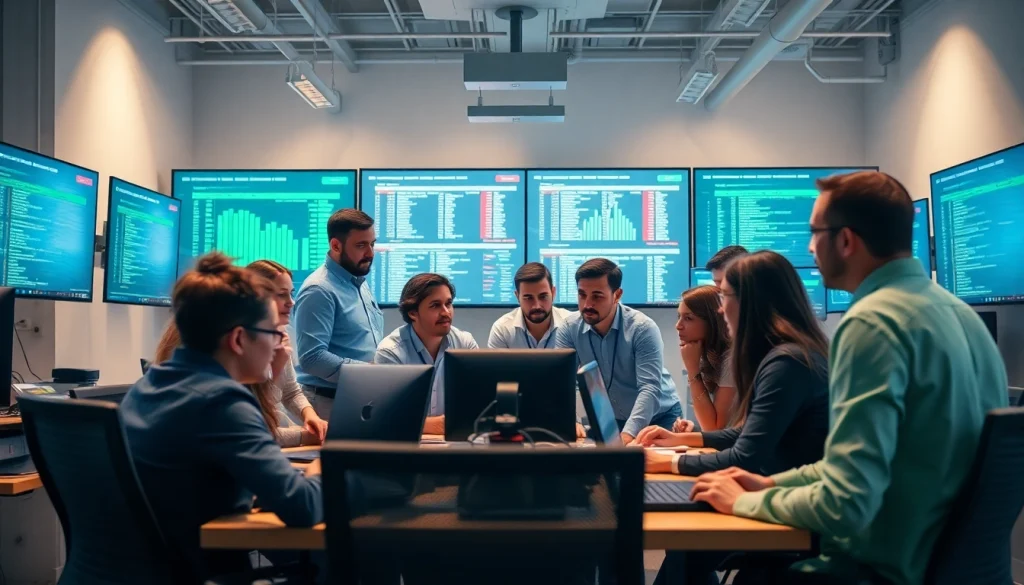
Understanding Site Reliability Engineering
Definition of Site Reliability Engineering
Site Reliability Engineering (SRE) is a discipline that integrates software engineering with IT operations to enhance the reliability and performance of services. Coined by Google, SRE aims to create scalable and highly reliable software systems. The essence of SRE lies in applying software engineering principles to solve operational problems, ensuring that services function seamlessly from deployment to production. This approach fosters a culture of collaboration between software developers and operations teams, resulting in quicker deployments, reduced outages, and improved service availability.
Importance of Site Reliability Engineering
In today’s fast-paced digital landscape, the reliability of applications and services is paramount. Users have high expectations regarding performance; they demand services that are not only quick but also available around the clock. Site reliability engineering experts help organizations meet these demands by proactively identifying and mitigating risks before they affect end users. By emphasizing reliability, SRE can also significantly reduce the operational costs associated with downtime and emergency response efforts.
Key Principles of Site Reliability Engineering
Several core principles guide Site Reliability Engineering practices:
- Service Level Objectives (SLOs): SREs define clear SLOs to measure the reliability of services, ensuring that teams have tangible metrics to strive for.
- Monitoring and Observability: Continuous monitoring of systems helps teams quickly identify issues in real-time, allowing for prompt resolutions.
- Automation: By automating repetitive tasks, SREs free developers to focus on high-value work, reducing human error and increasing efficiency.
- Incident Management: Establishing robust incident management processes ensures that teams can respond effectively to outages, minimizing downtime.
- Postmortems: Conducting postmortem analyses after incidents fosters a culture of learning, helping teams improve over time.
Roles of Site Reliability Engineering Experts
Core Responsibilities of Site Reliability Engineering Experts
Site reliability engineering experts have a range of responsibilities that revolve around ensuring the systems are robust and performing optimally. Their key responsibilities include:
- System Design: Collaborating with development teams to build scalable, reliable architectures.
- Performance Tuning: Analyzing system performance and making necessary adjustments to improve efficiency.
- Deployment: Overseeing the deployment of applications, ensuring minimal disruption to users.
- Incident Response: Responding to outages or degraded service performance, diagnosing issues, and implementing solutions.
- Capacity Planning: Assessing system capacity and predicting future resource needs.
Essential Skills of Site Reliability Engineering Experts
To effectively perform their duties, site reliability engineering experts must possess a blend of technical and soft skills, including:
- Programming Skills: Proficiency in programming languages such as Python, Go, or Java is crucial for automation and scripting tasks.
- Systems Knowledge: A deep understanding of operating systems, networking, and cloud platforms is essential for managing complex infrastructures.
- Problem-Solving Abilities: Experts must possess strong analytical skills to diagnose issues and implement effective solutions rapidly.
- Communication Skills: Effective communication is key for collaborating with development teams and conveying technical information to non-technical stakeholders.
- Adaptability: As technology and business needs evolve, SREs must be flexible and open to adopting new tools, practices, and methodologies.
How Site Reliability Engineering Experts Collaborate with Development Teams
Collaboration between site reliability engineering experts and development teams is vital for achieving SRE goals. There are several ways this collaborative relationship is fostered:
- Shared Responsibility: SREs and developers share the responsibility for service reliability, encouraging a culture where reliability is everyone’s job.
- Continuous Feedback: Implementing feedback loops between development and operations teams ensures continuous improvement of services based on real-world usage data.
- Joint Planning: Involving SREs in the early stages of project planning helps in designing systems that are built for reliability from the ground up.
- Training: SREs often conduct training sessions for development teams to empower them with knowledge about reliability practices and principles.
Best Practices for Effective Site Reliability Engineering
Implementing Automation in Site Reliability Engineering
Automation is a cornerstone of Site Reliability Engineering, as it can significantly enhance the efficiency and reliability of systems. Here are effective practices to implement automation:
- Infrastructure as Code (IaC): Using IaC tools allows teams to provision and manage infrastructure through code, reducing human error and enabling consistent environments across all stages of development.
- Automated Testing: Implement automated testing in CI/CD pipelines to ensure code quality and functionality before production deployment.
- Chaos Engineering: Simulating failures in a controlled environment helps teams discover weaknesses in systems before they cause real outages.
- Alerting and Monitoring Tools: Implement monitoring tools that automatically alert engineers to anomalies, allowing for quicker incident response.
Monitoring and Incident Management Techniques
Effective monitoring and incident management are pivotal for maintaining operational excellence. Techniques include:
- Real-Time Monitoring: Utilize monitoring dashboards that provide real-time insights into system performance, such as response times, traffic loads, and error rates.
- Service-Level Indicators (SLIs): Define SLIs that can help measure service health more effectively and provide insights into user experience.
- Incident Response Plans: Develop and regularly update incident response plans that outline steps to follow during service outages.
- Post-Incident Reviews: Conduct reviews after incidents to analyze the root cause and implement improvements in both processes and systems.
Continuous Improvement in Site Reliability Engineering
A culture of continuous improvement is fundamental in SRE. Strategies to enforce this culture include:
- Regular Training: Conduct regular training sessions and workshops to keep the SRE team updated on the latest tools, methodologies, and industry best practices.
- Feedback Mechanisms: Implement feedback mechanisms that empower teams to provide input on process changes and improvement opportunities.
- Metrics Review: Periodically review performance metrics and SLOs to identify areas for enhancement, informing planning for future development.
- Encouraging Experimentation: Foster an experimental culture where teams are encouraged to test new tools, processes, and workflows to find what works best.
Challenges Faced by Site Reliability Engineering Experts
Managing Complex Systems and Dependencies
As services grow, so do their complexities and dependencies. Managing intricate interconnections between systems can become challenging and may result in cascading failures. To mitigate these risks, experts should:
- Woodpecker Testing: Implement woodpecker testing to understand how systems react under different failure scenarios, ensuring that each subsystem functions correctly independently and collectively.
- Dependency Mapping: Create clear maps of dependencies to visualize how services interact and to pinpoint potential failure points.
- Regular Updates: Keep documentation updated to reflect changes in system architectures and design, which aids in onboarding new engineers and facilitating troubleshooting.
Addressing Security Concerns in Operations
Ensuring that services are not only reliable but also secure is a significant challenge for SREs. Best practices to enhance security include:
- Security by Design: Integrate security considerations into the design phase of services rather than as an afterthought.
- Regular Audits: Conduct regular security audits to identify vulnerabilities and rectify them promptly.
- Continuous Learning: Stay abreast of the latest security threats and trends to proactively defend against potential breaches.
Navigating Organizational Changes Effectively
Organizational changes, such as team restructuring or shifts in technology, can disrupt service reliability efforts. To navigate these effectively, SREs can:
- Change Management Processes: Implement structured processes to manage change, ensuring that all stakeholders are informed and prepared for transitions.
- Cross-Functional Teams: Foster cross-functional teams that include SREs, developers, and product managers to facilitate smoother transitions and minimize friction during changes.
- Maintain Open Communication: Encourage open lines of communication to share knowledge and address any concerns arising from organizational changes.
Future Trends in Site Reliability Engineering
Emerging Technologies in Site Reliability Engineering
As technology continues to evolve, several trends are shaping the future of Site Reliability Engineering:
- Serverless Architectures: Serverless computing simplifies deployment and scalability, shifting the focus from managing infrastructure to delivering code.
- Containers and Microservices: Containerization allows services to be developed and deployed in modular fashion, enhancing flexibility and scalability.
- Observability and AIOps: The rise of artificial intelligence for IT operations (AIOps) brings sophisticated monitoring and anomaly detection tools that can automate responses and provide deeper insights into system performance.
The Rise of Artificial Intelligence in Operations
Artificial intelligence is making significant inroads into operations, particularly in the realm of incident management and predictive analytics. By leveraging AI, SREs can:
- Predictive Maintenance: AI can help predict failures before they occur, allowing teams to address issues proactively.
- Automated Incident Response: AI algorithms can analyze alerts and automatically trigger responses, reducing the manual intervention needed.
- Enhanced Data Analysis: AI can analyze large volumes of data to reveal patterns that might not be visible to human analysts, informing decision-making processes.
Skills for the Next Generation of Site Reliability Engineering Experts
The demand for skilled site reliability engineering experts is growing, requiring professionals to continuously evolve. Future-focused skills include:
- Cloud Proficiency: Familiarity with various cloud platforms and services is crucial as more organizations shift to cloud-native architectures.
- Data Analytics: Proficiency in data analytics frameworks will enable engineers to gain insights from performance data more effectively.
- Cross-Disciplinary Knowledge: A solid understanding of both software development and IT operations will be critical for SREs.





